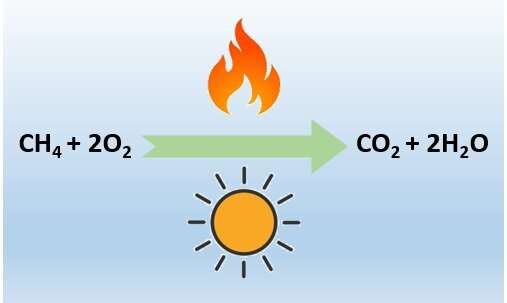This article has been reviewed according to Science X's editorial process and policies. Editors have highlighted the following attributes while ensuring the content's credibility:
fact-checked
trusted source
proofread
Exploring catalytic methane removal to mitigate its environmental effect

A new review published in Science China Chemistry has summarized recent progresses in the oxidation of methane via both thermocatalysis and photocatalysis through the lens of environmental remediation. The review was led by Prof. Junwang Tang, Department of Chemical Engineering, University College London; and Department of Chemical Engineering, Tsinghua University.
"Methane, with its huge reserve and wide application, has caused a strong greenhouse effect due to its high global warming potential nearly 30 times that of CO2. Catalytic oxidation of methane directly to CO2 offers a potential pathway to mitigate the adverse impact caused by methane emission," Tang says.
"Traditional thermocatalysis uses noble metal or transition metal and their oxides as catalysts to convert methane into CO2 and H2O with O2 at high temperatures. Alternatively, photocatalysis opens a green pathway to drive this reaction at ambient conditions in the presence of a photocatalyst and under light irradiation. Development of methane removal process via both thermocatalysis and photocatalysis hold[s] great importance in scientific research, and significant potential in large-scale applications as well."
The recent catalytic methane oxidation processes are thus reviewed as follows:
- The development of thermocatalysts, especially Pd-based catalysts are summarized and compared
- The deactivation of thermocatalysts at high temperatures and in the presence of H2O, sulfur contents, etc., is discussed
- Fundamental studies on the evolution of catalysts and surface chemistry during the catalytic process by advanced spectroscopies and microscopies are reviewed
- The synthesis and performance of photocatalysts for methane oxidation are compared
- The underlying photophysics and surface chemistry processes in photocatalytic methane oxidation are discussed to guide future studies.
Future work should focus on the development of efficient thermocatalysts work at lower temperatures or photocatalysts response to visible light. Reactor design is another important aspect to improve the overall performance of the reaction; however, it is overlooked in many studies.
More information: Chao Wang et al, Catalytic methane removal to mitigate its environmental effect, Science China Chemistry (2023). DOI: 10.1007/s11426-022-1487-8
Provided by Science China Press




















